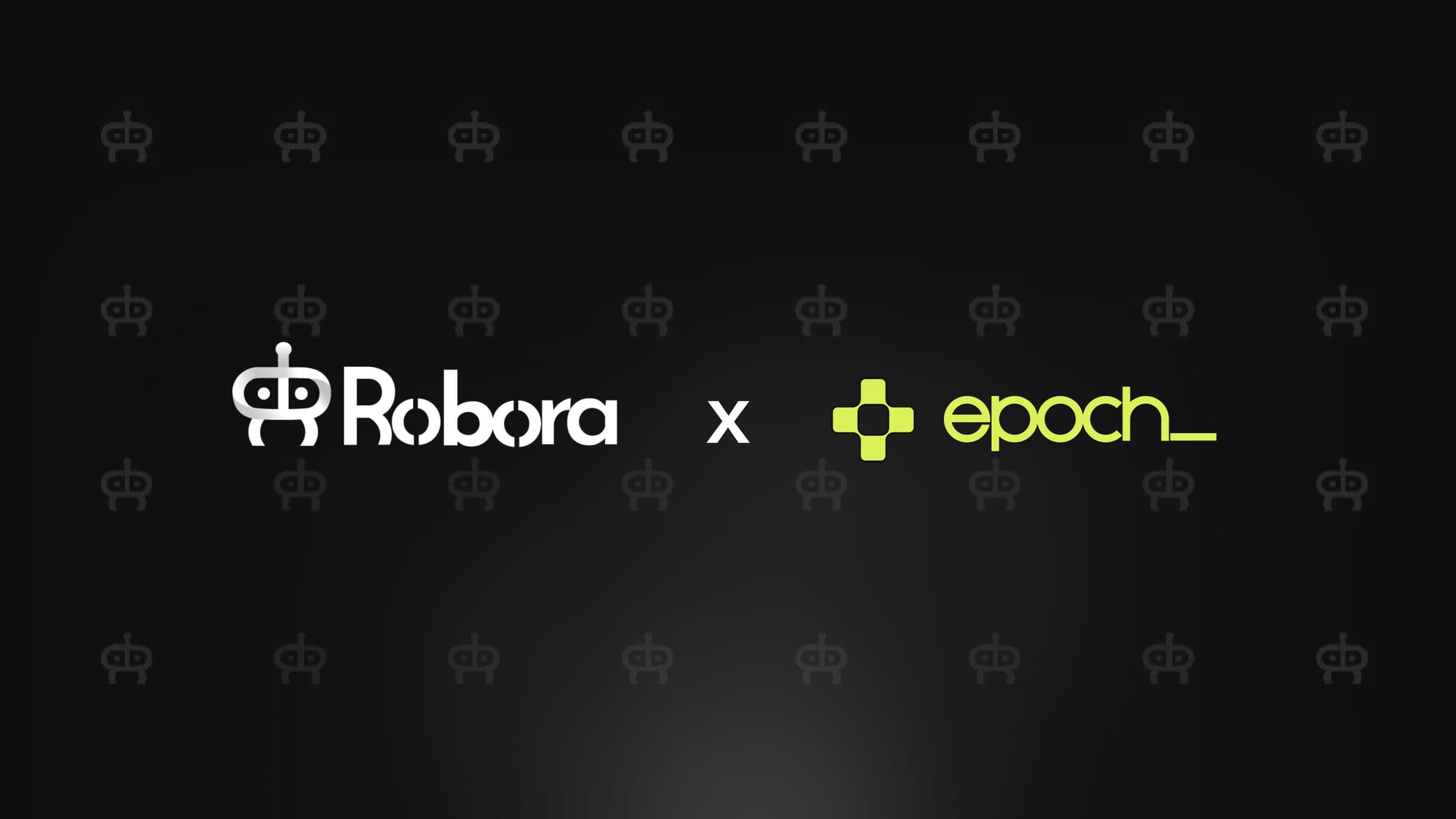Robora: Coordinating Robotics as an On-Chain Market

Deploy robots in any modern warehouse and you'll discover the industry's dirty secret. The Amazon robots can't talk to the Fanuc arms. The Tesla bots won't share data with Boston Dynamics systems. Every manufacturer built their own walled universe, which limits the potential and growth of robotics.
A warehouse robot learns the optimal route after a thousand runs. That knowledge stays trapped in that specific robot. Meanwhile, your other robots are learning the same routes from scratch, burning compute, wasting time. The inefficiency compounds with every new machine you add.
Robora isn't building better robots. They're building the coordination layer that lets all robots work together. Train a robot once, deploy that intelligence everywhere. Every task generates cryptographic proof of work. Every learned behavior becomes a tradeable asset.
While crypto chases AI agents that live on Twitter, Robora is coordinating actual machines doing actual work. This isn't another robotics company with a token. It's the marketplace the entire industry desperately needs.
The Fragmentation Problem
Every robotics company faces the same challenges. Sensor logs from different manufacturers don't align. A warehouse robot's navigation data can't transfer to an industrial arm. Fleet coordination requires separate control systems for each vendor.
The real cost hits when you try to scale. Deploy ten robots from three different vendors and you need three engineering teams, three data pipelines, three control systems. A robot learns the optimal path through your warehouse after a thousand runs. Your other robots start from zero, learning the same lessons, wasting the same compute.
This fragmentation creates massive inefficiencies. Companies spend more on integration than on the robots themselves. Innovation slows because every breakthrough stays locked in proprietary silos.
Robora's answer is the Synergy Grid Framework. A four-layer architecture that gives all robots a common language:
(Intake → Fusion → Propulsion → Emission)
The Intake Layer takes sensor data from any robot and standardizes it. Doesn't matter if it's LIDAR from a drone or force feedback from a gripper. Everything gets normalized.
The Fusion Layer. It combines multiple data streams and applies AI models to actually make decisions. Raw inputs become actionable intelligence here.
The Propulsion Layer translates high-level commands into hardware-specific actions. So the same pick up object command works whether you are controlling a humanoid or an industrial arm.
The Emission Layer handles external communication, fleet coordination, and blockchain settlement. This is where physical work becomes economic value.
The documentation claims 1.2-1.5x task speedups with this setup. Not earth-shattering, but when you're running hundreds of robots, those improvements add up. The whole thing runs through the Nexus Hub. Think of it as decentralized air traffic control for robots, routing jobs and managing compute resources while maintaining cryptographic audit trails.
Physical AI
The core of Robora is Physical AI. Portable robot brains built around a VLA loop(Vision-Language-Action). These aren't just static programs. They perceive through sensors, reason using AI models, then act through whatever hardware they're running on.
Physical AI's run locally on edge devices (think Jetson boards) for quick responses, but they can tap into the Grid when they need serious compute power. Once you've trained a Physical AI, it becomes a reusable asset. Train it on one robot, deploy it on completely different hardware.
Let's say you're a warehouse operator. You train a Physical AI to efficiently sort packages using your specific setup. You can then list that Physical AI on the marketplace. Every time someone else's robot uses your Physical AI, you earn royalties. Your proprietary knowledge becomes a revenue stream.
The Marketplace: Where Hardware Meets Economics
Robora's marketplace isn't just a store, it's the economic engine of the entire ecosystem. And the economics actually make sense.
Creators can design robots or train Physical AIs, then list them with smart-contract royalties. The typical split is 70/20/10 (designer/platform/rewards pool). One can increase its exposure by staking some $RBR. Want to track performance? Built-in analytics.
Node operators are the backbone, providing compute power. If you're running an edge node handling real-time robotics workload, you keep 95% of job fees. Cloud nodes doing batch processing get 85%. This pushes infrastructure to the edge, exactly where robots need it.
Data contributors get the best deal - 100% of rewards for sharing operational data. Smart move, since this solves the classic cold-start problem. Early participants get paid to bootstrap the datasets everyone else will need.
The actual Deploy & Operate flow is straightforward. Device owners escrow $RBR, node operators process jobs, and Proof-of-Task receipts get hashed on-chain to unlock payment. You get an immutable record of work done and automatic settlement. No invoices, no payment delays.
Tokenomics
$RBR isn't just another governance token floating around doing nothing. It's the actual currency that makes this robotic economy work.
Fixed supply of 100M on Ethereum - no inflation surprises. There's a 4% trading fee that gradually steps down to 0% as the project hits milestones. The team cant rug with a 60-month liquidity lock and 24-month vesting. And you actually need $RBR for real things: builder access, marketplace transactions, node staking.
Platform fees get partially converted to $RBR, which creates natural buy pressure and funds the staking rewards pool. More activity means more demand for the token.
The Technical Foundation
Looking at Robora's data stack, you can tell actual engineers built this. They use programmable collection for flexibility, AI quality scoring to validate data, standardized formats like Parquet so everything plays nice together, and off-chain storage (IPFS/cloud) with cryptographic hashes for scale.
They're not trying to shove everything on-chain. Blockchain handles what it's good at - coordination and settlement. Heavy data stays off-chain where it belongs.
What's Coming: The 3D Builder
The big milestone everyone's watching is the web-based 3D builder launching Q4 2025. It's a drag-and-drop tool that lets anyone design robots without coding, exports to standard formats (URDF for ROS compatibility), and lets you attach Physical AI for intelligence.
Think about what this means. A small manufacturer could design a custom inspection robot, grab a pre-trained Physical AI from the marketplace, and have the whole thing manufactured, all without writing a line of code. That's the gateway for non-technical users to actually participate in the robotics economy.
They're also building SDK integrations with the tools robotics teams already use - ROS 2, Webots/Gazebo, NVIDIA Isaac. Not trying to replace everything, just building bridges to existing infrastructure.
The Investment Thesis
Robora sits at a unique intersection. You've got DePIN, AI agents and the robotics boom. But unlike pure narrative plays, there's a real problem being solved with clear economic incentives.
The bull case is straightforward. If Robora captures even 1% of robotics coordination, that's a massive opportunity. They're not competing with robot manufacturers, they are building the market infrastructure everyone needs. Classic picks and shovels play for physical automation.
Of course there are risks. Two-sided marketplaces are hard to bootstrap, even with token incentives. The technical complexity is real. Getting enterprises to adopt anything new takes forever. But the efficiency gains are compelling enough to drive adoption once they prove it works.
Why This Could Actually Work
Most blockchain projects try to decentralize everything. Robora is smarter than that. They're using blockchain for what it actually does well; coordination, incentive alignment, and trustless settlement. Local execution stays local. Heavy compute stays off-chain.
If they nail the builder MVP and show real Proof-of-Task volume, this proof-of-physical-work concept has alot of potential. We're talking about physical robots doing real work, settling payments through crypto rails, with value automatically flowing to everyone who contributed.
The timing is perfect. Robotics is exploding. AI capabilities are going parabolic. DePIN needs real use cases beyond weather stations. Robora connects all three with something that actually generates value.
This isn't another chatbot pretending to be revolutionary. It's not a meme token with a robotics theme. It's infrastructure for the physical economy. And honestly, in a world where robots are everywhere, whoever controls the coordination layer might end up more valuable than the robots themselves.
The robotics market doesn't need another manufacturer. It needs a marketplace.
Robora is building it.


